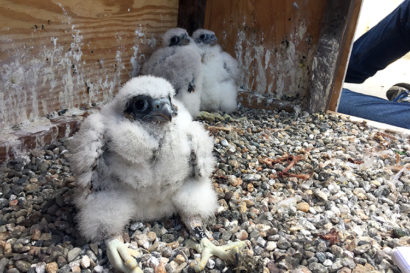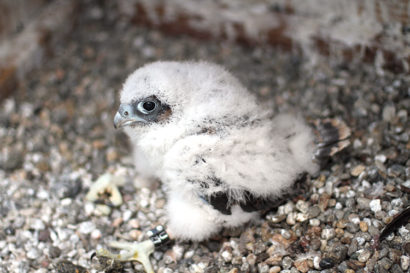Peregrine falcon cameras installed on the Campanile
The pair that has raised its young atop Berkeley’s bell tower for the past two years — and made headlines — can now be observed 24/7 by anyone in the world
February 5, 2019

One of the Campanile’s peregrine falcons flies over campus. (UC Berkeley photo by Maria Garcia Alvarez)
Can’t get enough of the Campanile peregrine falcons? The pair that has raised its young atop Berkeley’s bell tower for the past two years — and made headlines — can now be observed 24/7 by anyone in the world.
After a successful crowdfunding effort that brought in more than $14,500, UC Berkeley, working closely with state and federal agencies, has installed two cameras on the second balcony of the Campanile so people can watch the peregrines — and their chicks in the spring — all day, every day.
In fall 2019, a third camera was installed on the south balcony. Viewers can watch all three cameras at the same time on the Cal Falcons page.
Get the latest updates on the Cal Falcons Facebook page.
“The cameras will allow students, the campus community and the public to watch the birds — to see how they interact and observe the eggs as they hatch, then the chicks as they grow and learn to fly,” says Carla Cicero, staff curator of birds at UC Berkeley’s Museum of Vertebrate Zoology.
Learn more about the Campanile peregrine falcons — how they chase their prey at more than 200 miles per hour through the crowds on campus, and if they’re here to stay. The story and relating photos are available online on Berkeley News.
“We hope that educating the public on raptor nesting activity will encourage people to be more respectful of natural habitat and lead people to pursue careers in environmental studies and other related fields of study,” adds Mary Malec, a volunteer raptor nest monitor with the East Bay Regional Park District.
Malec says the eggs could be laid anywhere from the middle of February to the end of March, but based on the past two years, they will probably be laid in early March. Eggs are laid about every two days — peregrine falcons typically lay between three and five eggs a season. After the third egg is laid, the birds will partially incubate the eggs, but the eggs will be left uncovered most of the time, says Malec. However, the adult falcons will stay close by to protect the eggs. Chicks hatch after 33 to 34 days of incubation.

Three peregrine falcon chicks hatched in spring 2018 — two males (front and back left) and a female. (UC Berkeley photo by Maria Garcia Alvarez)
In spring 2017, the peregrine couple hatched its first clutch of chicks, which were named Fiat and Lux in a campus community contest. This past spring, three more were born, attracting national media attention and suggestions for names for the trio from enthusiasts all around the world. (They were named Californium, Berkelium and Lawrencium — after three elements discovered at Berkeley).
During those two nesting cycles, volunteers came together to sit at the bottom of the 307-foot tower around the clock for a week, waiting for the chicks to fledge, or take their first flights.
Being able to monitor the birds by camera instead of with binoculars will make their jobs a lot easier, says Malec.
The video camera clamped on the balustrade right in front of the nest, on the west-facing second balcony, has infrared capabilities, so it can capture video at night. It also has an internal lens, so it can pan 180 degrees without any of the camera’s moving parts being visible to the birds.
One of the first chicks born on the Campanile — named Lux by the campus community — hit a wall and died a week after she started flying. Listen to Carla Cicero, the staff curator of birds at the Museum of Vertebrate Zoology, as she prepares Lux to be a specimen in the museum’s collection.Story and photos on Berkeley News.
The second video camera, in the tower’s northeast corner, provides a view of the balconies on the east and north, where chicks spend a lot of time running around and flapping their wings before they fledge. Only the Campanile’s south side isn’t visible by camera.
Peregrine falcons are are a federally protected species under the Migratory Bird Treaty Act. It is illegal to disturb nesting peregrines, and only authorized personnel can enter the Campanile’s second balcony during nesting season.
The $14,526 in donations, given by 172 people, has mainly been used to purchase and install the camera equipment and to set it up to livestream the videos. Cicero says she also hopes to use some of the funds to hire a student intern to help with research, video archiving and preparation of educational materials.
Donors who gave $25 or more were given a chance to suggest names for the adult peregrines. Of the nearly 50 submissions, the fundraising team chose “Annie,” after Annie Alexander, a renowned naturalist and philanthropist who founded the University of California’s Museum of Paleontology and Museum of Vertebrate Zoology; and “Grinnell,” after Joseph Grinnell, who was hired by Alexander to be the founding director of the Museum of Vertebrate Zoology. Grinnell extensively catalogued the fauna of California in the hope that future scientists could use the information to see an accurate snapshot of how much the state had changed.

A male peregrine chick, born last year, sits in its nest box after it was banded by experts. (Photo by Mary Malec)
Cicero says the campus will need more funds for camera maintenance and repair, and to install a permanent network line to the camera setup. People who would like to donate can visit the Cal Falcons Fund.
The public can learn more about peregrine falcons on Saturday, April 13 on Cal Day — UC Berkeley’s
annual open house — at a special exhibit from 9 a.m. to 4 p.m. at the Museum of Vertebrate Zoology.
Doug Bell, wildlife program manager for the East Bay Regional Park District and a UC Berkeley alumnus, will give a talk from 11 a.m. to 12 p.m. The Cal Day website will go live on Thursday, March 28.
The campus falcons also have their own Facebook page — with photos, videos and descriptions of their nesting and parenting behavior.
